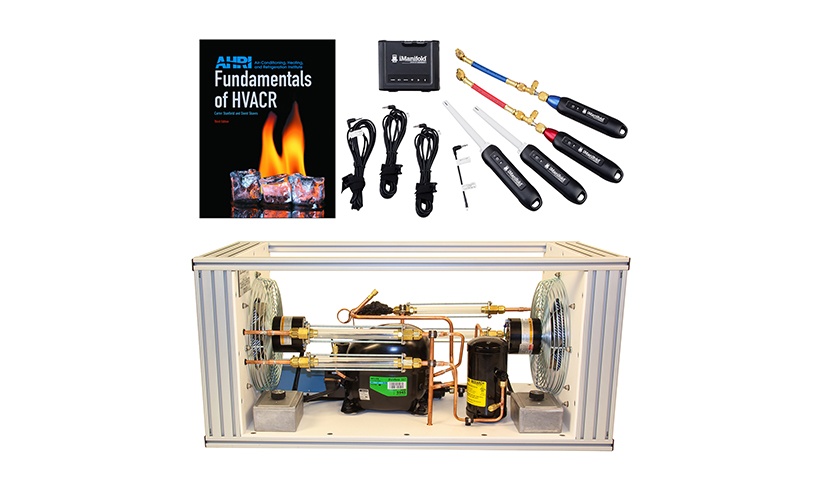Basic Refrigeration Fundamentals

Introduces the basic concepts, theories, and safety regulations and procedures of refrigeration. Topics include an introduction to OSHA, laws of thermodynamics, pressure and temperature relationships, heat transfer, the refrigerant cycle, refrigerant identification, and types of AC systems.
Learning Experience Outline
1. Practice Safe Work Habits
- Module 1 Objectives - Practice Safe Work Habits
- 1.1 Presentation - OSHA Regulations
- Slide 1 - Overview
- Slide 2 - Employer Responsibilities
- Slide 3 - Employee Responsibilities
- Slide 4 - Required Training
- Slide 5 - Required Training continued...
- Slide 6 - Common Workplace Injuries
- Slide 7 - Fall Protection
- Slide 8 - Fall Protection continued...
- Slide 9 - Ladder and Scaffold Safety
- Slide 10 - Ladder and Scaffold Safety continued...
- Slide 11 - Confined Space Safety
- Slide 12 - Permit Confined Space Safety
- Slide 13 - Permit Confined Space Safety continued...
- Slide 14 - Electrical Safety
- Slide 15 - Electrical Safety continued...
- Slide 16 - Refrigerant Safety
- Test 1.1
- 1.2 Presentation - Refrigerant Safe Handling Practices
- Slide 1 - Refrigerant Safety Overview
- Slide 2 - Refrigerant Cylinders
- Slide 3 - ASHRAE Standard 34
- Slide 4 - ASHRAE Standard 34 continued....
- Slide 5 - Slide 3 - ASHRAE Standard 34 Image
- Slide 6 - Zeotropes
- Slide 7 - PPE for Handling Refrigerants
- Test 1.2
- Video 1.2 - Safe Refrigerant Handling Practices
- 1.3 Presentation - Safe Use of Portable Fire Extinguishers
- Slide 1 - Fire Extinguisher Overview
- Slide 2 - P.A.S.S.
- Slide 3 - Types of Extinguishers
- Slide 4 - Type ABC
- Slide 5 - Fire Extinguishers
- Lab 1.1 - Fire Extinguisher
- Module 1 Completion
2. Demonstrate a Knowledge of Refrigeration Science
- Module 2 Objectives - Demonstrate a Knowledge of Refrigeration Science
- 2.1 Presentation - Matter and Energy
- Slide 1 - Matter
- Slide 2 - Solids
- Slide 3 - Solid continued...
- Slide 4 - Solid continued...
- Slide 5 - Liquids
- Slide 6 - Liquids continued...
- Slide 7 - Liquids continued...
- Slide 8 - Gases
- Slide 9 - Gases continued...
- Slide 10 - Gases continued...
- Slide 11 - Physical Properties of Matter
- Slide 12 - Density
- Slide 13 - Specific Volume
- Slide 14 - Specific Gravity
- Slide 15 - Energy, Work and Power
- Slide 16 - Energy
- Slide 17 - Work
- Slide 18 - Power
- Slide 19 - Watt's Law
- Video 2.2 - Thermodynamics
- Lab 2.1 - Heat Transfer
- Lab 2.2 - Sensible and Latent Heat
- Test 2.2 - Thermodynamics
- Video 2.3 - Pressure-Temperature Relationships
- Lab 2.3 - Compression and Expansion
- Lab 2.4 - Boiling Point
- Lab 2.5 - Saturated Pressure-Temperature(1)
- Lab 2.6 - Saturated Pressure-Temperature(2)
- Test 2.3 - Pressure-Temperature Relationship
- 2.4 Presentation - Refrigerants
- Slide 1 - Refrigerant Overview
- Slide 2 - Refrigerant Chemistry
- Slide 3 - Refrigerant Chemistry continued...
- Slide 4 - ChloroFluoroCarbons
- Slide 5 - HydroChloroFluoroCarbons
- Slide 6 - HydroFluoroCarbons
- Slide 7 - HydroFluoroOlefins
- Slide 8 - Compounds
- Slide 9 - Blends
- Slide 10 - Zeotropes
- Slide 11 - Azeotropes
- Slide 12 - Zeotropes continued...
- Slide 13 - Azeotropes continued...
- Slide 14 - Halogenated Refrigerant Numbering
- Slide 15 - Halogenated Refrigerant Numbering continued...
- Slide 16 - HCFC-22
- Slide 17 - HFC-134a
- Slide 18 - Environmental Impact
- Slide 19 - Natural Refrigerants
- Slide 20 - Refrigerant Oils
- Test 2.4 - Refrigerants
- 2.5 Presentation - Identifying Refrigerants
- Slide 1 - Identifying Refrigerant in a Cylinder
- Slide 2 - Temperature and Pressure
- Slide 3 - Pressure-Temperature Chart
- Slide 4 - Using the iConnect to Identify Refrigerants
- Slide 5 - iManifold
- Slide 6 - iManifold App
- Lab 2.7 - Refrigerant Cylinder Identification Using iManifold
- Lab 2.8 - System Refrigeration Identification Using iManifold
- Module 2 Complete
3. Describe the Operation of Different Types of Cooling Systems
- Module 3 Objectives - Describe the Operation of Different Types of Cooling Systems
- Video 3.1 - Comfort Conditions & Types of Cooling Systems
- Lab 3.1 - Comfort Conditions
- Test 3.1 - Comfort Conditions and Types of Cooling Systems
- Module 3 Complete
4. Explain the Operation of the Vapor Compression Refrigeration Cycle
- Module 4 Objectives - Explain the Operation of the Vapor Compression Refrigeration Cycle
- Video 4.1 - Vapor Compression Cycle Operation
- Test 4.1 - The Vapor Compression Refrigeration Cycle
- 4.2 Presentation - Drawing the Vapor Compression Cycle
- Slide 1 - Cycle Review
- Slide 2 - Cycle Review continued...
- Slide 3 - Cycle Review continued...
- Slide 4 - Cycle Review continued...
- Slide 5 - Cycle Review continued...
- Slide 6 - Cycle Review continued...
- Slide 7 - Label Refrigeration System Components
- Lab 4.1 - Drawing Refrigeration Cycle
- Video 4.2.1 - Refrigeration Cycle Components
- Lab 4.2 - Refrigeration Cycle Components
- Test 4.2 - Refrigeration Cycle Applications
- 4.3 Presentation - Refrigerant Changes During the Refrigeration Cycle
- Slide 1 - Cycle Review
- Slide 2 - Cycle Review continued...
- Slide 3 - Refrigerant Changes - Compressor
- Slide 4 - Refrigerant Changes Through the Compressor
- Slide 5 - Refrigerant Changes - Condenser
- Slide 6 - Refrigerant Changes Through the Condenser
- Slide 7 - Refrigerant Changes - Metering Device
- Slide 8 - Refrigerant Changes Through the Metering Device
- Slide 9 - Refrigerant Changes - Evaporator
- Slide 10 - Refrigerant Changes Through the Evaporator
- Slide 11 - Refrigerant Changes Through the System
- Video 4.3.1 - Different Refrigeration System Applications
- Lab 4.3 - Describe Refrigeration Cycle Operation
- Module 4 Complete